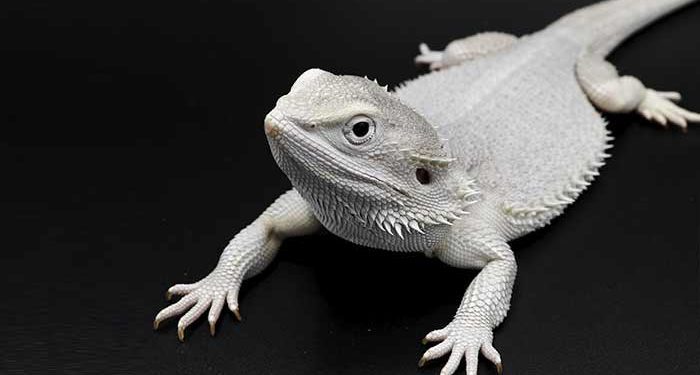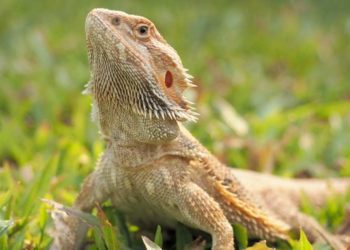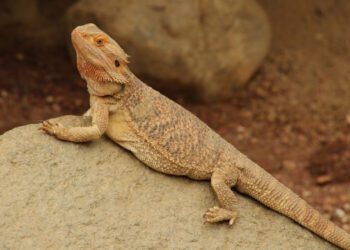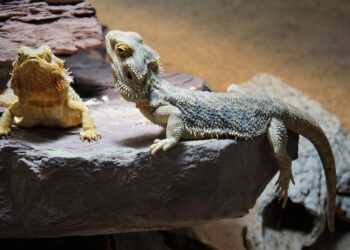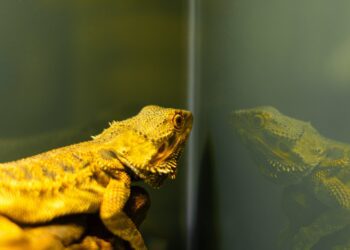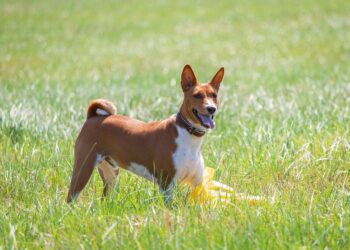There are about eight species of bearded dragons and Pogona Vitticeps is the most popular one. Only four species of bearded dragons can be kept as a pet. They have different appearances and all these species come from Australia. White-bearded dragons are one of them. Bearded dragons come in different patterns, colors or something referred to as morphs or mutations.
Morphs explain the type or size of the bearded dragon. Bearded dragon morphs have different colors but they also have different head shapes, scales, nail colors, spikes, and patterns. White-bearded dragons completely lack melanin and have white scales on them. They are also known as Zero or Albino bearded dragons.
They are also called Zero bearded dragons because they do not have usual markings like patterns and colors other than the standard bearded dragons. They have an almost white color due to a lack of melanin.
Albino bearded dragons are not something to be taken very lightly. They are not the most difficult pets to care of but have a particular set of needs that must be met to keep your dragon’s good health. So if you are thinking to keep a white-bearded dragon as your pet, you need to know everything about them.

Contents
Facts about White Bearded Dragons
- Common Name: Bearded Dragon
- Scientific Name: Pogona Vitticeps
- Care: Moderate
- Size: 15-23 inches
- Lifespan: 6-8 years
- Nature: Omnivores
- Temperature: 70-100˚F
- Humidity: 21-40%
- Tank Size: 29-30 gallons
Are White Bearded Dragons Good Pet?
Many people love to pet bearded dragons but the thing is that they are worried about the question is bearded dragon safe to keep as a pet in the family. So here are the answers to all your queries. Bearded dragons are good pets for families as well as families having children but need a responsible adult who keeps an eye on the pet properly.
But you have to be very careful about their diet and health because it is a kind of difficult task to take care of. As they require a time-to-time meal, proper maintenance, and attention. They are relatively easy to handle but only require consistent care by someone.
The appearance of White Bearded Dragon
White Bearded Dragons are very mysterious as they because they lack color and sometimes pattern. Bearded dragons turn white because they shed color naturally. These bearded dragons have different colors according to region. They are bright white in hotter areas while gray in cooler regions.
An adult bearded dragon grows up to two feet long and sometimes smaller than this. White-bearded dragons or morphs are rare and harder to find and that is why are very expensive than others.

How to Take Care of White Dragon?
You have to be very careful about the surroundings and environment of your pet dragon. All these include the size of the tank in which you will keep your dragon, tank conditions, and more important lighting, temperature maintenance, and bearded dragon’s habitat. Here we will discuss each factor deeply. So let’s start with the environment of the dragon.
What is Vivarium?
It is an enclosed environment to house a reptile in it which is just like a tank that is made up of glass and other materials. It is just like an aquarium to fish or like a terrarium for plants. The natural habitat of bearded dragons is hot as they are species of Australia which is a hotter place.
To keep your pet dragon happy and healthy, you have to create an environment just like their natural habitat or as close as possible. Also, bearded dragons have some needs which are non-negotiable and you have to provide for them.
- Things to climb for a dragon
- Proper room to move freely
- Some places to hide itself
- Temperature range
- Some area to dig
Tank
There are different sizes and styles of tanks available according to your demands. It is important from your dragon’s health point of view that you should provide them a safe tank in terms of size, structure, and also setup. Tanks are made up of different materials like glass, melamine PVC, and many other products.
Tanks are available with varying options of openings so that you can easily manage your dragon. The front opening of the tank is best as it gives you easy access to care for and feed your pet. It is important to get the right size tank for each stage of the dragon. The ideal size of a tank for an adult bearded dragon is 60-120 gallons.
Check: Best 5 Bearded Dragon Terrariums
Temperature
Bearded dragons enjoy a place where the temperature range varies between 95-110˚F. Their tank should maintain this temperature range. To keep a warm and happy place, try to maintain your tank temperature at around 85˚F.

Lighting
Bearded dragons require a lot of light that reflects their natural environment. Providing the full spectrum light through UVB bulbs helps to stimulate their appetite and provides the vitamin D to help them absorb calcium. They must provide 12-14 hours of light every day which also level their mood.
Also check: 5 Best UV Meters For Bearded Dragon
Substrate
The substrate is a kind of floor or soil that is provided in the tank to provide the dragon with natural habitat. If you are bringing a new pet home, then reptile carpet is the safer option because wood chips, sand, pebbles are dangerous for your dragon. Paper towels and newspapers are also good options and save your money too.
Vivarium Characteristics
- Tank Type: Glass terrarium
- Tank Size: 39-40 gallons
- Heating: Heating pad
- Lighting: UVB/UVA light fixtures for 12 hours a day
- Best Substrate: Reptile Carpet
What to Feed to White Bearded Dragon?
Whit bearded dragons need a variety of food in their diet because they are omnivores in nature. Most of their nutrition is coming from vegetables and insects. These dragons also eat some fruits, leaves, and herbs as a salad once or twice a month. Food that white-bearded dragons love to eat is small rodents like mice, spiders, worms, crickets, flowers, squash, carrots, zucchini, fruits and beat greens.
Check out : Best 7 foods for Bearded Dragons
Summary of Diet
| Insects | 65-70% of diet- small worms, crickets, spiders etc |
| Meat: | As a treat only but very rarely
|
| Vegetables | Around 25-30% of diet
|
| Supplements | Calcium and Vitamin D3 |
How to Keep Your Dragon Healthy?
First of all, a healthy and balanced diet is the key to keeping your pet healthy. Further, if the tank would be too dirty or your dragon is not getting enough light then you have to face many problems. So keep the habitat of bearded dragons clean and provide adequate light as well as diet. These two are the key points to keep your pet healthy and happy.
Health Issues in White Bearded Dragons
Bearded dragons are very good pets if you look after them with a great diet and healthy environment. Common health issues that occur in white-bearded dragons are respiratory infection, parasites, metabolic pain disease, mouth rot, and adenovirus infection.
Among all, metabolic bone disease is a complex and very common health problem in white-bearded dragons and is most commonly seen in less than two years old dragons and cause by feeding improper diet to them having high phosphorous amount and low in calcium and vitamin D3.
Infectious stomatitis is a bacterial infection of the gums and jawbones. Respiratory infection commonly known as pneumonia occurs in dragons that are not properly feeding or kept in a dirty and cold place. It can also be caused by parasites, fungi, viruses, and bacteria.
Handling Advice of Bearded Dragons
It is easy to handle bearded dragons because they are very cool and docile. Bearded dragons respond better when you speak to them. If you have a baby dragon then you have to handle it very carefully and avoid sudden movements and loud noises.

Also, avoid grabbing the tail of the dragon and be careful around their head because most of the sensory organs of white-bearded dragons are present there which makes them quite uncomfortable and stressful.
Shedding of White Bearded Dragons
Shedding also known as ecdysis is a natural process that every bearded dragon goes through. Bearded dragon’s skin does not stretch with age so they have to shed their old skin for new skin. This process is called shedding. To grow to continue, they must shed their old skin. Bearded dragons shed either due to growth or replacing their damaged skin.
Shedding occurs almost weekly for less than 6 months old dragons. Between 6-12 months, the shedding will be less frequent, and the growth rate increase. As the age increases, shedding becomes less frequent because muscle and bone growth is done.
Another reason for shedding is damaged skin. When beardie’s skin surfaces get damaged, scrapped, dirty, and battered due to their environment, they shed their skin. When a dragon does not shed properly its skin becomes dull, tight, and changes the color of skin which is normal.
Are White Dragons Rare?
Yes, white-bearded dragons are extremely rare than other morphs and have very high costs. These white dragons are around three times more costly than other dragons.
Pros of White (Zero) Bearded Dragon
- They have a very docile nature
- Handling is easy
- Diet is not very complex
- Friendly to humans
Cons of White (Zero) Bearded Dragon
- Very sensitive to their surrounding
- Require more care
- Require a lot of space to live
- Housed separately
Conclusion
White-bearded dragons are very rare and unique-looking animals that a lot of reptile lovers want to have. As they are rare, their cost is also very high than other reptiles. They do not need very high maintenance and are very friendly pets. They just require an eye on them from an adult and need to keep their habitat maintained. Above all, they are loving family pets and it is very amazing to watch and interact with them.


